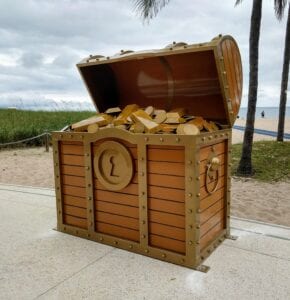By Don Gialanella
. . .


Preserving the natural surroundings in terms of not causing environmental damage is of primary importance in placing public sculpture. Ironically, the act of installing a sculpture at a site changes the visual environment of that site, hopefully for the better, while not introducing any toxic substances that may be present in the finishes or materials used in fabricating the art.
Public art during its lifespan is destined to become part of the technical life cycle of raw material, production, and finally recycling. I propose an idea to consider making a piece of public art that conforms to the biological life cycle of nutrient (materials), growth (fabrication), and ultimately biological decomposition.
In an effort to cause no harm, public sculpture should employ non-polluting, permanent materials – stainless steel, corten steel, stone, and bronze. For example, I had the opportunity to create a sculpture for the City of Pompano Beach, FL, that was installed at the bottom of the ocean attached to the deck of a shipwreck as part of an artificial reef in late 2020. The object was to cause no marine pollution while the sculpture became part of the artificial reef system.
I have also created interactive projects for the Cities of Ft. Myers and Clearwater based on recycling awareness. The idea was for visitors to insert their empty single use water bottles into the sculptures to complete the design.

In public art there is a very practical emphasis on permanence. But permanence is relative. Sometimes in an effort to extend the lifespan of public art, noxious finishes and sealers are applied to the surface of murals and sculpture to prolong the finish or deter graffiti. Do we expect public art to last more than a few years, a decade, a lifetime, several generations, centuries, millennia? What is the logical expiration date expectation?
After all, even great mountains erode into deserts over the span of geologic time. I’d like to design a sculpture that naturally evolves, ages, and deteriorates as part of the natural order, like an integral part of the biological process of decay and rebirth. Art that slowly changes, erodes, and eventually contributes its nutrients back into the biosphere.
. . .
You can explore Don Gialanella’s work at donsculpture.com


